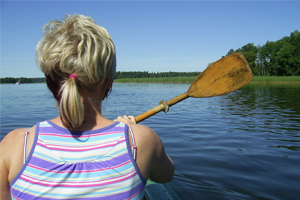 Whether used on a lake, river, or on the sea, paddling a canoe or kayak is an excellent form of low-impact exercise that can improve your flexibility, strength and overall fitness. In addition, it lets you get out in the beauty of nature where you may find that paddling a canoe or kayak puts you in a meditative state and brings about a sense of peace.
Whether used on a lake, river, or on the sea, paddling a canoe or kayak is an excellent form of low-impact exercise that can improve your flexibility, strength and overall fitness. In addition, it lets you get out in the beauty of nature where you may find that paddling a canoe or kayak puts you in a meditative state and brings about a sense of peace.
Both canoeing and kayaking use similar techniques, but there are a few differences between the two. A canoe is open, and the paddler either kneels or sits in it while using a single-bladed paddle to steer the canoe. A kayak is usually enclosed, with the paddler sitting with their legs extended in front of them, and uses a paddle with a blade at each end.
Canoeing and kayaking can improve your health in a number of ways. It increases cardiovascular fitness without putting excessive wear and tear on your joints, builds and tones the muscles in your arms, back, chest and shoulders, and increases strength in your torso and legs, which are used extensively to properly paddle the vessel.
If you are just getting started in canoeing or kayaking, joining a club is a good way to ease yourself into the sport so as to be taught the proper techniques and to get a feel for it before investing in your own equipment. You should also be a competent swimmer, as it is inevitable that you will capsize every now and then. A good club or course will teach you how to safely recover from turning over in the water.
The basic idea of good technique in kayaking or canoeing is to treat the vessel like an extension of your body. People who are new to the sport usually make the mistake of using only their shoulders and elbows to paddle, which is very tiring and hard on the body. By also involving your legs and torso you will increase your endurance and will not be in as much pain after a long day of paddling.
The proper way to propel a kayak is to keep the paddle held out in front of your body, keeping your arms as straight as you can. Then with the blade as perpendicular to the water as possible, drop the blade into the water and pull back on it while keeping your arms straight and twisting your torso, using your legs for leverage. Pull back until the blade is just even with your hips, then lift it from the water and drop the opposite blade into the water in a similar manner. Pulling the blade any further back will only result in wasted effort.
Paddling a canoe is done similarly, though one hand is placed on the end of the paddle and the other at the neck of the blade. With arms straight, keep the blade as vertical as possible while leaning forward and pulling the blade firmly down into the water, close to the side of the canoe, while twisting with your torso.
Whether you choose a thrilling kayak trip down a rushing river or a serene canoe ride on a calm lake at sunset, canoeing and kayaking are good for both body and spirit.

